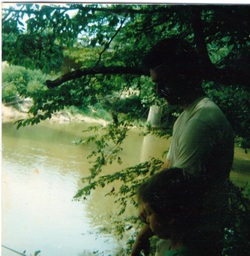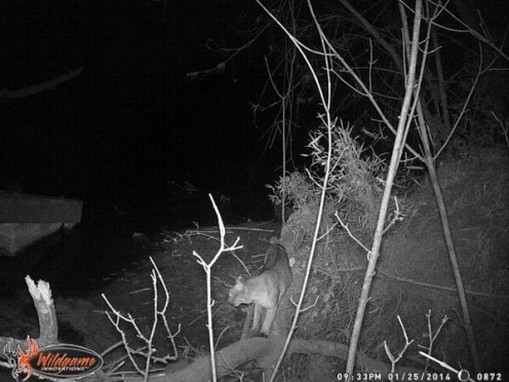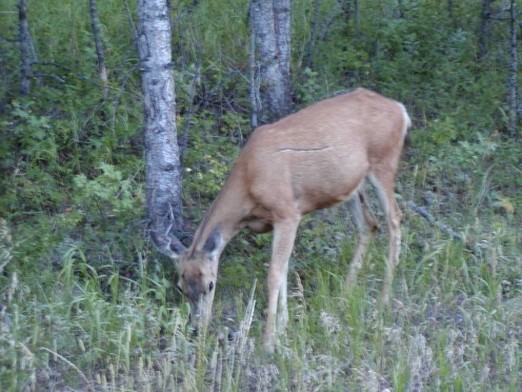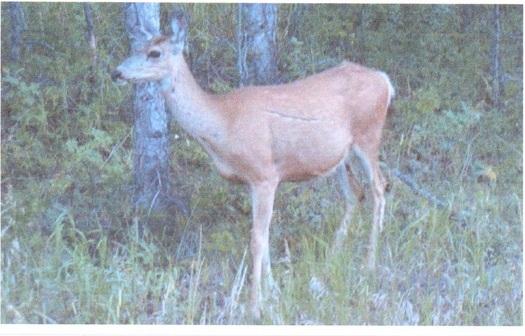 Fishing Creek 1987- track discovered next year about a half mile downstream from this spot
Fishing Creek 1987- track discovered next year about a half mile downstream from this spot Splash! I saw it jump while kneeling on a narrow, natural earth bridge across Fishing Creek, about ten miles or so below Mt. Airy, N.C.; called Mayberry by some, being the hometown of the late, great, Andy Griffith.
It was a warm and overcast day back then in the summer of 1988. I was about half a mile down the spot where a road crossed over this, varying, maybe ten to twenty foot wide creek, when a very big small- mouthed bass made leap beside a partially sunken tree limb, probably going after some flitting insect.
With some Georgia wiggler worms, and a Zebco rod n reel in hand, there was really no alternative but to try and catch and release that monster. The only problem was how to get close enough to toss that hopefully enticing worm near the limb without snagging the hook, and let the creek's slow current carry it right past where I believed the bass was hiding under the wood. On the big limb's side, there was a sloping embankment covered in foliage and other difficult to get through obstructions -- so that way was probably going to be out.
On the other bank it appeared to be about a thirty foot struggle through some thick briers, short bushes and stinger plants. The latter was chosen and a stout stick found as a poor substitute for a machete. Necessity is the mother of invention however, and the stick did a pretty decent job of getting through the tangled-up flora.
When the optimal spot to cast the bait was reached, almost right across from where the fish had jumped, there appeared a small break in the plant growth, where six feet or so from the creek, a slanted mud bank ascended up a couple of feet to grassy ground that covered a large field, or perhaps meadow is the better word for it.
And there it was.
At the moment of looking at the mud bank leading up to the meadow, I saw a sight that was not only startling but very nearly bowled me over. The big bass wasn't going to see any Georgia wiggly-worms right away, nor were any of the catfish or bream in the stream going to see one either for that matter, as I now had something else to ponder on for the rest of the day and a long time to come.
What this boy beheld in the middle of that moist mud was the biggest cat track he'd ever seen in the wild by far. On eyeing it closer my amazement went up some more, for then I was almost certain -- knowing the native animal tracks fairly well -- that this almost assuredly wasn't made by any super-sized bobcat or even a very large dog. [ At this point it should be noted that big dog prints are sometimes mistaken for cougars as they don't always leave claw marks; at any rate, the track was unlike any big dog print I'd ever, or have since, ever seen.]
The print, perfectly formed and recent, was indelible and set the mind to wondering then and for ever after. It was as best could be measured by the fingers 3 x 3 1/2 square inches in size, but was probably closer to 10 or 10 1/2 inches in total. From that day forward, the significance of the discovery aside, the assumption that the big mountain cats no longer roamed those parts, was gone for good as far as I was concerned.
Before we proceed with the story a few things are in order: Fishing Creek, at least at the time back then, was a low-populated area of Surry County, N.C. From the creek's head water, roughly a good mile and a half or so, which is about as far as I ever went down it, had no housing or commercial development in sight. Now that's possibly changed some over the intervening twenty-five years, but it was a nice, secluded fishing stream back then. When it rained and muddied the water up considerably, one could pull catfish out of it by the bucket full.
What to my intuition was a very clever animal, had approached the creek from a hilly and wooded expanse. Crossing the creek, it then went up the bank onto the grassy meadow as mentioned before, which was interspersed with copses of medium-sized trees. The small town and county seat of Dobson was in that direction, but could have easily been skirted by any smart and large animal headed for a mountain fastness in the nearby Blue Ridge. It was also full of small game with a healthy deer population, as both were often sighted by me while fishing, especially in the early morning.
The big cat crossed the water at the hardest, most inaccessible place on the entire length of the stream I was familiar with. It was definitely an area no man or dog in their right mind -- unless by an extremely unusual situation -- would ever be near. There was even that dirt bridge not thirty or so feet away. Why would it choose the most difficult part of the water to cross, which right there at that spot, was a deep and maybe 12-foot wide stream? Happenstance? Single-mindedly zeroed in on a prey animal? Or was something else going on?
Not so long ago the U.S. Fish & Wildlife department formally announced the Eastern Cougar extinct. Yes, the American Eastern Cougar is no longer extant -- presumably meaning east of the Mississippi River. Those that think they are make some good points, and those who think not do as well.
Ever since revelations concerning the Kennedy and MLK assassinations, the Vietnam War tragedy and the Watergate scandal, a majority of the American people have rightly been rather hesitant to believe absolutely and without question, certain official announcements.
This is not meant to say all such announcements are in error, or disparage the many truthful, hard-working and excellent people who work in an official capacity, no, it's just a factual statement available for reading and viewing in many popular history books, television series and reliable internet sources.
The following two old anecdotal stories and all the sighting history in North Carolina could speak for many other areas along this very ancient chain of mountains. The steep peaks and thick foliage of eastern Tennessee, eastern West Virginia and northern Georgia in particular for the southern section of the Appalachians.
Mountain Lions, or "Painters", as they were often called in the past, were fairly common in the N. C. mountains up until the 20th century. Unrestricted hunting -- with bounty's paid for the "varmints" - and the extensive timber cutting by the sometimes voracious lumber companies, took a heavy toll on the animals.
Even what is now the Great Smoky Mountains National Park was nearly half-logged; but the North Carolina mountains still retained steep and heavily forested areas thousands of square miles in extent, where the wiliest cats could remain reproducing and roaming about to a reduced degree. Perhaps, they simply adapted.
The Smokies greatest early 1900s hunter and guide, a man who knew the region better than anyone else, was once asked if he'd ever been lost in them. His answer went something like: "Well, not exactly, but I have been known to wander 'round and 'round a bit at times."
The following is an account of supposedly the last "Painter" slain in the Great Smokies during the winter of 1920. A mountaineer named Tom Sparks was nearly mauled by what appeared to be an injured mountain lion as he herded sheep on Spence Hill. Attacks like this were quite rare in these eastern mountains however.
During the assault he managed to inflict a deep shoulder wound on the cat with presumably a firearm. Many months later, a W. Orr slew a panther near Fontana Village, ( which is a tourist attraction now, with the very beautiful, man-made, 900 foot deep Fontana lake nearby). Orr found that its left shoulder blade had been cut in two. This was thought to be the same cat Sparks had shot and the last of its kind in the immediate area, but not in the mountains as a whole.
A late 19th century story has two mica prospectors chancing on an abandoned cabin during a savage blizzard. Due to blood spots, horrible cries, crashes on the roof and foot-falls, the men concluded the place was haunted, or hainted, as the vernacular had it back then. In the morning mountain lion tracks were found and the mystery solved. The cats had a den nearby on a wild and rugged precipice and had been using the cabin as an additional home. Soon after a systematic hunt was organized with all four panthers treed and killed after a long chase.
The list of sightings, video, and other evidence are far too numerous to include even a goodly portion of them here. Presumably the Fish & Wildlife says if they're there, they have to be released pets or zoo escapees. The supposition that a very small remnant survived the attempt at extermination might seem the more likely answer to some people, though.
The continuity of sightings through time along with the craftiness these cats often display, says more to me than just free running ex-pets who've been propagating with each other all these years. But even if that's the reality, the fact remains they do appear to be extant in the southern mountains and, some northern parts of the Appalachians too.
Whatever the case may be, the reports continue to come in: a late night crossing was reported by two well-respected gentlemen in the north-west corner of the state recently. A relative, an experienced outdoorsman, unmistakably sighted one recently on an eastern branch of Lake Santeehelah, about 15 miles from the Great Smokey Mt. National Park. When he reported it to a Wildlife person, they told him it had to have been a bobcat; not so according to the relative, who clearly saw a very long tail on the large tawny feline as it slouched between the thickets.
Hind-sight is 20/20 and I do wish that way back then I'd returned and taken pictures of the track and reported it. A good photo could have at least confirmed it as a mountain lion print or some other large species. So with that said, the following is only a loose theory of mine and I in no way claim it to be the complete or even right answer but here it is.
Something happened in the first half of the twentieth century, where the few remaining indigenous cats had a new survival strategy come to the fore. They largely removed themselves to the most remote and inaccessible parts of the mountains -- as far away from human beings as it was possible to get. Possibly even deep into places like the vast Cohutta wilderness in NW Georgia.
Many of them now knew, whether instinctively -- or by independent thought, that when the baying of hounds was near, their usual last ditch defense of treeing meant death. Later on in the century they possibly mated up with some released pets or escapees. As to why they are rarely killed on the roads, like almost all other large, and many not so large wild mammals, they've generally gone nocturnal in their main activities.
When they do venture near them late at night, they know the danger and cross quickly. How many bears does one see on the side of the road? it's not often they're hit, and although bears are not dumb animals, I believe the cats are not only smarter but much cannier. A good example of this difference might be the young Pennsylvania bear who made the news in 2013 by getting its head stuck in a plastic jar for at least 11 days. A young Eastern Mountain Lion would never make that mistake in my humble opinion.
Some will say this is all wishful thinking and perhaps in part they're right. Occasionally there are hoaxes or flights of fancy as one man has admitted to near Asheville, N. C., not so long ago. Apparently there was some kind of wish fulfillment fantasy about a mother and cubs. This is a good case to demonstrate the passions these cats can stir in people, that is, pro and con, as to their reality or non-reality east of the Mississippi watershed.
Whatever the case may be, I know what I saw and believe that the hundreds of reports through the years and up until today are largely made by honest folk, and are not always hoaxes, misidentifications, drug or drink fueled hallucinations or aerie-faerie nonsense. Reason just says that with all the reports, sightings, and other evidence, they must be extant to some degree.
One has, apparently, even tried to take down a horse in Lexington, NC recently, which is more in the western Piedmont section of the state. This would imply, they, like other species such as coyote and black bear, are extending their normal range on occasion. That is if wild-born mountain lion felines are still in our big Eastern Mts. to start with, of course. Indeed, if still there, this incident is a rarity as they appear to stay as far away from us and our domestic animals as it is possible for them to be.
What's left of the wild Appalachians may still hold mysteries for us to this day.
NOTE: View a new article on the subject by clicking the Carolina Critters tab for Mountain Lion Encounters in Georgia and the Alabama Sand Hills.




 RSS Feed
RSS Feed
